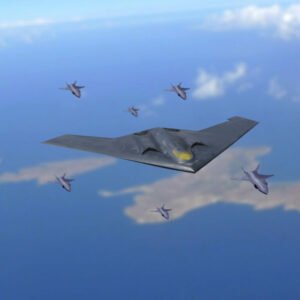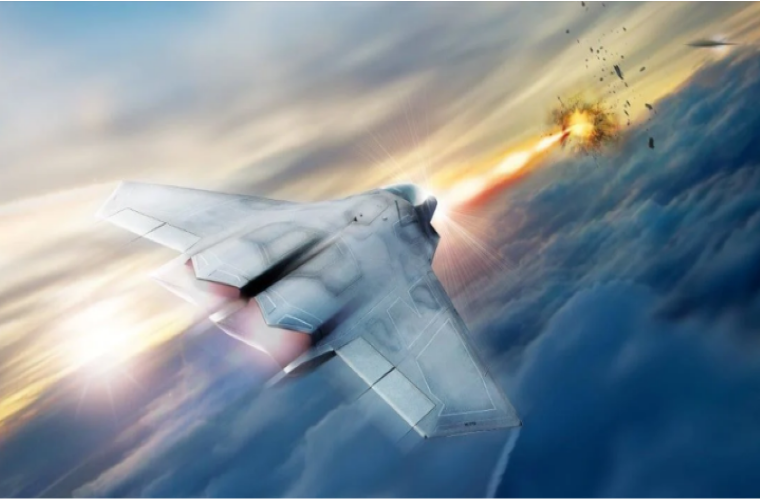The United States Air Force recently sent out a highly classified solicitation to its industry partners for the Next Generation Air Dominance (NGAD) program, with the goal of selecting a replacement aircraft for the F-22 sometime in 2024.
Part of the Department of the Air Force’s “Operational Imperatives,” the NGAD is ultimately expected to include a number of systems all working in concert instead of just a single fighter aircraft.
Due to the classified nature of the program, few details of the proposal have been released. However, what little is available in the Air Force’s recent solicitation seems to indicate that this new fighter will feature a number of technological, material, and performance advancements over the F-22, which is considered the state-of-the-art fighter in the world today.
Few Details in Solicitation of NGAD Fighter, But Some Tantalizing Hints
In a statement announcing the classified solicitation, the Secretary of the Air Force, Frank Kendall, offered a few insights into what features and advantages the NGAD fighter contractors will have to include.
“The NGAD Platform is a vital element of the Air Dominance family of systems which represents a generational leap in technology over the F-22, which it will replace,” said Kendall. “NGAD will include attributes such as enhanced lethality and the ability to survive, persist, interoperate, and adapt in the air domain, all within highly contested operational environments.
Although no specific details were offered, previous reports have noted that the goal of the NGAD program is a comprehensive collection of systems that will include at least one crewed aircraft along with a variety of uncrewed aircraft, advanced missile systems, versatile weapons pods, possible improvements in propulsion, and other features that can work in concert to achieve actual air dominance.
For example, the newer, more advanced sensor systems being employed by U.S. adversaries are reportedly starting to overcome the stealth capabilities of the F-22 in ways that are fundamental to the aircraft’s design and not something that can be engineered around or modernized. Therefore, it is almost a foregone conclusion that newer modern stealth materials and an even more stealthy shape are part of the NGAD aircraft’s requirements.
The “enhanced lethality” mentioned by Kendall is likely to include upgraded missile systems and possibly even anti-drone lasers currently under development by the Air Force. Other directed energy weapons like microwave weapons and even hypersonic missiles may also be on the table, as both are also under development by the U.S. Department of Defense.


Kendall also notes that the NGAD aircraft will include the “ability to survive (and) persist…within highly contested operational environments.”
The first part of this statement may be particularly telling since analysts have offered conflicting opinions on whether the aircraft will be even faster, more maneuverable, and fly at a higher altitude than the F-22 or if its advanced weapons and sensor systems may give the NGAD fighter enough of a tactical advantage that it will be designed to carry more fuel and stay on station longer than its predecessor. This latest comment from Kendall seems to hint that, at a minimum, the aircraft may prioritize an increased fuel-carrying capacity over dogfighting maneuverability.
The statement by Kendall on interoperability also hints at the ability of the fighter to cooperate with other systems, including unmanned systems that are allegedly under development to fly alongside the new fighter as uncrewed support aircraft. Notably, the press release by the Air Force expressly points out that “the Collaborative Combat Aircraft program is not part of this NGAD Platform source selection.” So even though the new solicitation may require the selected contractor to develop a fighter that can “interoperate” with uncrewed support aircraft like the CCA, those platforms will be developed separately.
Interestingly, this approach seems to be a key part of the Air Force’s thinking with the NGAD. Specifically, they clearly do not want to be tied to one manufacturer for the support and improvement of the aircraft as technology continues to advance. Instead, they want to create a versatile platform that can incorporate improved propulsion systems, weapons, sensors, and other technologies into the aircraft as they become available, regardless of the manufacturer. The Air Force says they hope that leveraging this open architecture approach will “invigorate and broaden the industrial base to deliver rapid and innovative warfighting capabilities.”
“This approach will enable the government to maximize competition throughout the life cycle, provide a larger, more responsive industry base and drastically reduce maintenance and sustainment costs,” they explain.
Air Force Hopes to Maintain Air Superiority with NGAD
The final part of the announcement notes that “Further information on the NGAD Platform’s technical and programmatic details are classified to protect operational and technological advantages.” This means that, for now at least, we can only speculate on what actual improvements contractors may ultimately have to incorporate into the NGAD to win the main system contract.
Still, the Air Force highlighted the critical nature of staying ahead of our adversaries in their 2002 fiscal budget, noting that the NGAD program “ensures we maintain air superiority in the future by introducing game-changing technology now.”
“No one does this better than the U.S. Air Force,” Kendall said, “but we will lose that edge if we don’t move forward now.”
Christopher Plain is the Head Science Writer at The Debrief as well as a Science Fiction and Fantasy novelist. Follow and connect with him on Twitter, learn about his books at plainfiction.com, or email him directly at christopher@thedebrief.org.

